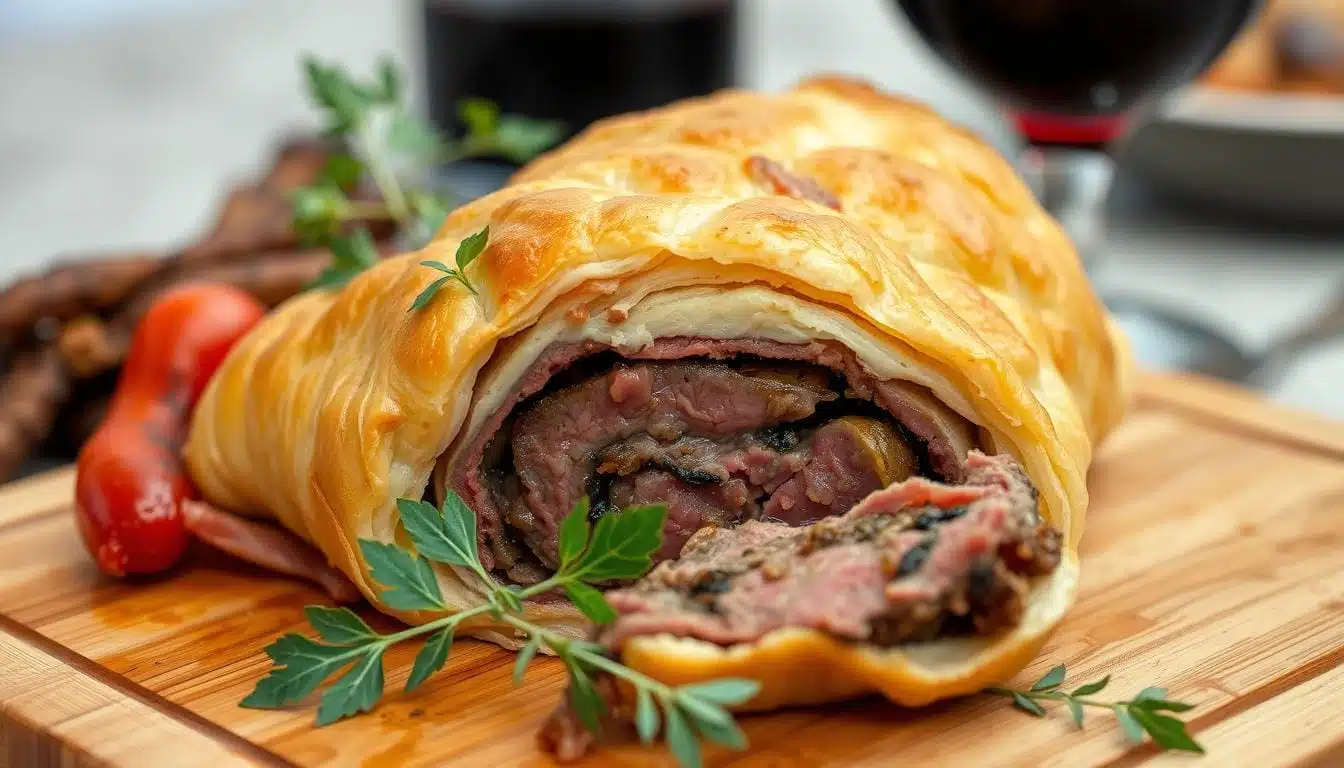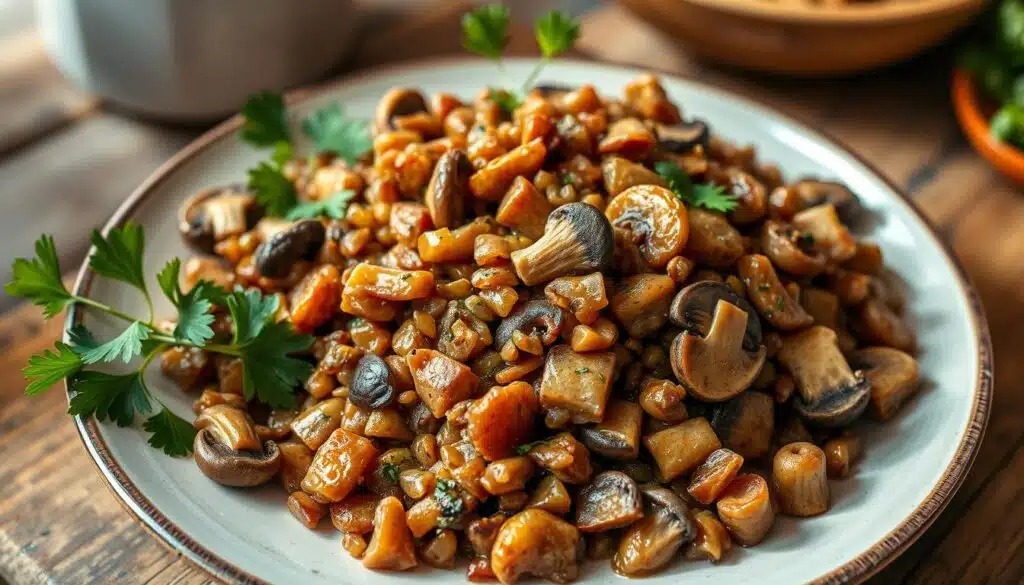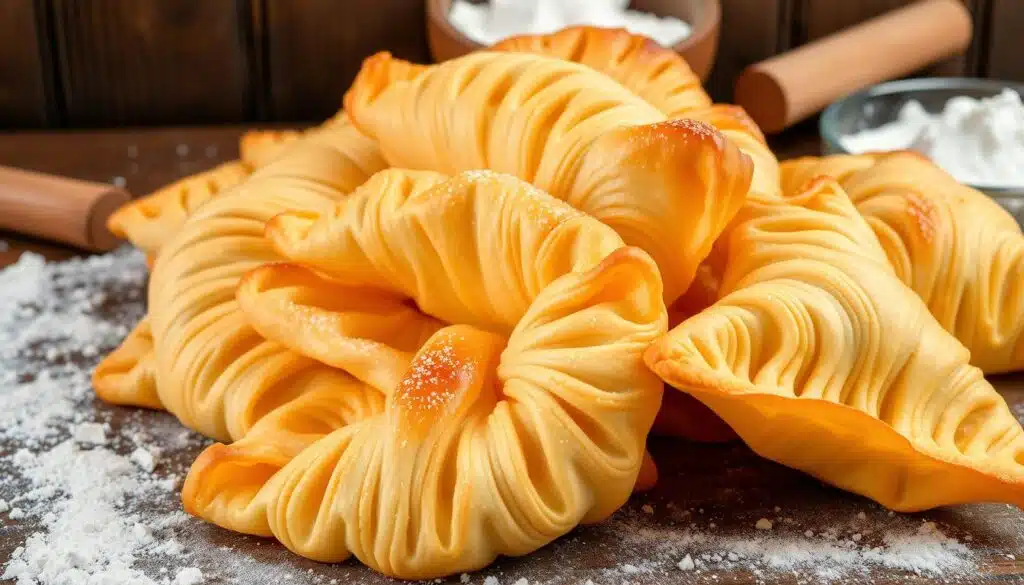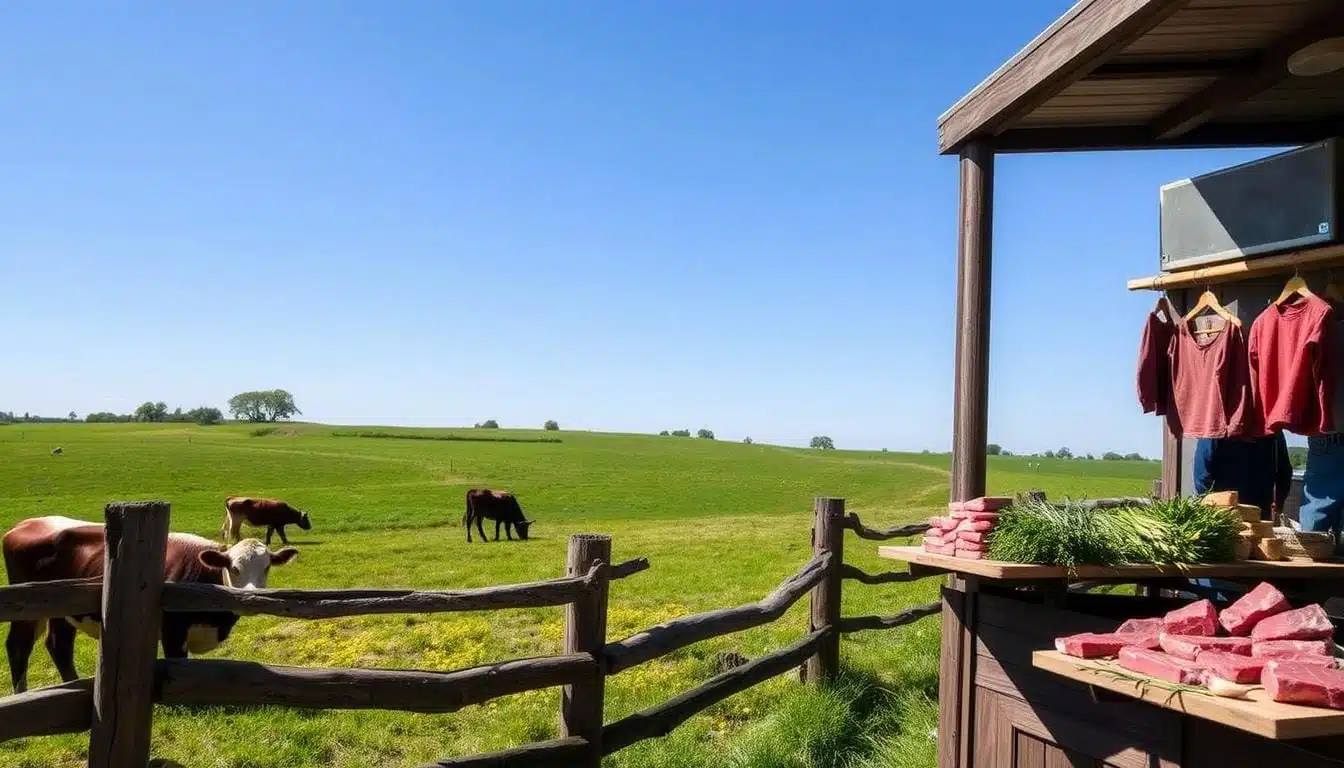Make Gordon Ramsay’s Perfect Beef Wellington at Home

Beef Wellington, a dish loved by many, is now within reach for home cooks. Thanks to Gordon Ramsay, you can make this gourmet dish in your kitchen. But, what makes Ramsay’s Beef Wellington so special, and can you make it just as good at home?
Table of Contents
Understanding the Classic Beef Wellington Legacy
Beef Wellington is a dish loved by food lovers everywhere. It has a long history, starting in the early 19th century. It was a favorite among the British aristocracy.
Origins of This Iconic Dish
The dish is named after the Duke of Wellington. He was a famous military leader and statesman. It’s said the dish was made to honor his victory at the Battle of Waterloo in 1815.
Gordon Ramsay’s Signature Touch
Gordon Ramsay made Beef Wellington even more famous. His version uses a beef tenderloin, mushroom duxelles, and puff pastry. It’s now the top choice for this dish.
Why This Recipe Stands Out
Gordon Ramsay’s Beef Wellington is special because of his focus on detail. He chooses the best beef tenderloin and makes the duxelles carefully. Every step is to make the dish taste and feel amazing.
“Beef Wellington is a classic dish that showcases the very best of British cuisine. It’s a true celebration of the finest ingredients, crafted with precision and skill.”
–Gordon Ramsay
Essential Ingredients for the Perfect Wellington
Making the famous beef fillet Wellington needs top-notch ingredients. At its core is the beef tenderloin, a tender and flavorful cut. It’s paired with a fragrant mushroom duxelles, a mix of mushrooms, shallots, and herbs that adds a rich taste.
The prosciutto wrapping adds a touch of saltiness and keeps the beef fillet moist. The puff pastry wraps it all up, making it a beautiful and tasty dish.
Seasonings like salt, pepper, and herbs like thyme or rosemary boost the flavors. Each part is crucial for a delicious beef fillet Wellington.
- Beef fillet – the star of the dish, known for its unparalleled tenderness and flavor
- Mushroom duxelles – a savory blend of finely chopped mushrooms, shallots, and herbs that adds depth and umami
- Prosciutto – a delicate, salty wrapping that protects the beef fillet and adds flavor
- Puff pastry – the light and flaky casing that transforms the dish into a visually stunning centerpiece
- Seasonings – such as salt, pepper, thyme, or rosemary, to enhance the overall flavor profile
“The perfect Beef Wellington is all about finding the right balance of flavors and textures – the tender beef fillet, the savory mushroom duxelles, the salty prosciutto, and the light, flaky puff pastry. When executed with care, it’s a true culinary masterpiece.”
Selecting and Preparing the Beef Tenderloin
Making the perfect beef tenderloin, also known as the beef fillet, is key to a delicious wellington recipe. The meat’s quality and how it’s prepared are crucial. Here’s a guide to picking and preparing the best cut for your homemade beef wellington.
Choosing the Right Cut
The beef tenderloin is the most tender and prized part of the cow. It’s the best choice for your beef wellington. Choose a center-cut beef fillet that’s even in thickness and has no extra fat or sinew. It should weigh between 2 to 3 pounds for even cooking and enough for a group.
Proper Seasoning Techniques
- Season the beef tenderloin well with salt and pepper, making sure to cover all sides.
- Let the meat sit at room temperature for 30 to 60 minutes before cooking. This helps it cook evenly.
- Think about adding herbs and spices like thyme, rosemary, or garlic to boost the wellington recipe‘s flavors.
Temperature Guidelines
The secret to a perfectly cooked beef wellington is getting the beef tenderloin to the right temperature. Aim for medium-rare, which is 130°F to 135°F on a meat thermometer. After cooking, let the beef fillet rest for 10 to 15 minutes. This lets the juices spread evenly throughout the meat.
Mastering the Mushroom Duxelles
The secret to a perfect beef wellington is the mushroom duxelles. It’s a savory mix that’s the heart of this dish. Learning to make the duxelles right is key to a delicious mushroom duxelles that goes well with the beef and pastry.
Start by picking fresh mushrooms like cremini, button, or shiitake. Chop them finely so they mix well with other ingredients. Cooking the mushrooms until they’re dry and flavorful is important.
Next, sauté the mushrooms in butter or olive oil. Add herbs and spices like thyme, garlic, and Worcestershire sauce. Cooking them on medium heat lets the flavors mix and the texture become spreadable.
Watch the duxelles as it cooks. You want it thick but still spreadable. This keeps the pastry from getting soggy. Stir it now and then to get the right texture.
“The duxelles is the unsung hero of the beef wellington. It’s the glue that holds the whole dish together, both literally and figuratively.”
When the mushroom duxelles is done, let it cool a bit. This keeps the pastry’s butter from melting when you assemble the beef wellington. This step is key for a flaky, golden crust.

Getting the mushroom duxelles right is essential for a great beef wellington. With some practice and care, you’ll make a savory base for this dish that will wow your guests.
Perfecting the Prosciutto Wrapping Method
Wrapping the beef tenderloin in prosciutto is key to making a great Beef Wellington. It adds flavor and keeps the beef tenderloin moist. Learning how to wrap prosciutto well is crucial for a delicious dish.
Layering Techniques
Start by laying out the prosciutto slices in an overlapping pattern. Place the beef tenderloin in the middle, making sure it’s fully covered. Roll the prosciutto around the tenderloin, making sure it’s tight and even.
Finally, tuck the ends of the prosciutto under the roll to keep it in place.
Common Wrapping Mistakes
- Overlapping the prosciutto slices unevenly, leading to gaps or thin spots in the wrap
- Wrapping the tenderloin too tightly, causing the prosciutto to tear or the meat to become misshapen
- Leaving the ends of the prosciutto exposed, which can result in uneven cooking or drying out of the meat
By focusing on the layering and avoiding these mistakes, you can make sure the prosciutto enhances the Beef Wellington perfectly.
Working With Puff Pastry Like a Pro
Mastering puff pastry is key for a perfect beef wellington recipe. This dough is delicate and flaky, but with the right techniques, you can make a stunning dish.
First, thaw your puff pastry properly. This prevents cracking and makes it easier to work with. Roll it out on a lightly floured surface, applying gentle pressure for even thickness.
- Keep the puff pastry cold to keep it flaky. Chill it before and after rolling, and work fast to avoid warming it up.
- When moving the rolled-out puff pastry to your baking sheet, be careful not to stretch or tear it.
- For a golden crust, brush the puff pastry with an egg wash before baking. This adds shine and flakiness.
With these tips, you’ll get better at using puff pastry in your wellington recipe. Enjoy the process and feel proud of your homemade masterpiece.

“The key to working with puff pastry is to keep it cold and handle it gently. This will ensure a flaky, golden crust every time.”
Step-by-Step Beef Wellington Assembly Guide
Making the perfect beef wellington needs careful attention to detail. You must choose the best ingredients and learn how to assemble it. This guide will help you make a delicious beef wellington that will wow your guests.
Layering Order
The secret to a great beef wellington is in how you layer it. Start by seasoning your beef tenderloin with salt and pepper. Then, spread a layer of mushroom duxelles over the meat.
Wrap the duxelles-covered tenderloin with prosciutto slices. Overlap them a bit to make a smooth, protective layer.
Sealing Techniques
After adding the prosciutto, it’s time to put the beef wellington in pastry. Wrap it in puff pastry, pressing the edges to seal. Use a fork or your fingers to seal the seams tightly.
Decorative Touches
To make your beef wellington look professional, add some decorations. You can use leftover pastry to make patterns or shapes. Brush the pastry with egg or milk for a shiny, golden finish.
By following these steps, you’ll learn how to make a beef wellington that looks amazing and tastes incredible.
Cooking Times and Temperature Control
To make the perfect beef wellington, you need to control the temperature and cooking time well. Here are the key steps to follow:
Start by heating your oven to 400°F (200°C). This high temperature will make the crust golden and crispy.
- For medium-rare, cook for 30-35 minutes.
- For medium, cook for 35-40 minutes.
- For well-done, cook for 40-45 minutes.
Use a meat thermometer to check the beef’s internal temperature. For medium-rare, it should be 125°F (52°C). For medium, it’s 135°F (57°C). Let the beef rest for 10 minutes before slicing. This makes it tender and juicy.
| Doneness | Internal Temperature | Cooking Time |
|---|---|---|
| Medium-Rare | 125°F (52°C) | 30-35 minutes |
| Medium | 135°F (57°C) | 35-40 minutes |
| Well-Done | 145°F (63°C) | 40-45 minutes |
By sticking to these cooking times and temperatures, you’ll make a beef wellington that’s perfect. It will have a juicy inside and a crispy outside. It’s sure to impress your guests.
Resting and Serving Your Beef Wellington
After making the perfect beef wellington, the last step is to rest and present it well. This step makes the dish a true gourmet dish for special occasions.
Optimal Resting Period
After cooking the beef wellington to your liking, let it rest for 15-20 minutes before slicing. This lets the juices spread evenly, making the meat tender and flavorful. Don’t slice it right away, as the juices will spill out and ruin the taste and texture.
Presentation Tips
- Use a sharp, serrated knife to neatly slice the beef wellington into individual portions, maintaining a clean, professional appearance.
- Arrange the sliced beef wellington on a warm serving platter or plate, ensuring each piece is evenly spaced and visually appealing.
- Consider garnishing the dish with a sprig of fresh thyme or rosemary, adding a touch of elegance to the gourmet dish.
- Serve the beef wellington immediately, accompanied by your desired side dishes and sauces, to ensure the pastry remains crisp and the meat retains its juicy tenderness.
By following these simple resting and presentation guidelines, you can elevate your homemade beef wellington to the level of a true culinary masterpiece. It will impress your guests and satisfy your taste buds.
Troubleshooting Common Wellington Problems
Making the perfect beef wellington can be tough. But with the right tips, you can fix common problems. Whether it’s a soggy crust or overcooked beef, these solutions will help you get it right every time.
Soggy Pastry Crust
A soggy pastry crust often comes from too much moisture. Make sure to dry the mushroom duxelles well. Also, wrap the beef tightly in prosciutto. Don’t overfill the wellington, as this can make the bottom soggy.
Overcooked Beef
Getting the beef tenderloin just right is key. Use a meat thermometer to check the temperature. Keep an eye on it while it bakes. Let the beef rest for 10 minutes before slicing, as it will continue to cook.
Filling Leaks
If the filling leaks, it’s probably because of gaps in the pastry. Seal the edges well with an egg wash or water. Stretch and press the dough to make a tight, smooth wrap.
By tackling these common problems, you’ll get better at making beef wellington. Your dish will impress everyone.
Wine Pairing and Side Dish Suggestions
To make beef wellington truly special, choose the right wine and side dishes. This dish goes well with many wines and classic sides. These can turn a simple meal into a memorable dining experience.
Complementary Wines
Red and white wines both pair well with beef wellington. For a bold taste, try a full-bodied red like Cabernet Sauvignon or Malbec. Their strong tannins and fruit flavors match the beef and pastry’s richness.
On the other hand, a crisp white wine like Chardonnay or Sauvignon Blanc is refreshing. It cleanses your palate and highlights the mushroom flavors.
Classic Side Dishes
Beef wellington is rich, so choose sides that balance it. Roasted potatoes, a fresh green salad, or sautéed asparagus are great options. They add texture and flavor contrast, making the meal balanced.
| Wine Pairing | Side Dish |
|---|---|
| Cabernet Sauvignon | Roasted Potatoes |
| Chardonnay | Green Salad |
| Malbec | Sautéed Asparagus |
| Sauvignon Blanc | Garlic Mashed Potatoes |
With the right wine and sides, your homemade beef wellington becomes a gourmet dish. It will impress your guests and delight your taste buds.
Conclusion
In this guide, we’ve covered how to make Gordon Ramsay’s Beef Wellington at home. You now know the dish’s history and how to make it. You have the skills to create a gourmet masterpiece in your kitchen.
Choosing the best beef tenderloin and mushroom duxelles is key. Wrapping it in prosciutto and puff pastry is the final step. Now, you can make Beef Wellington like a pro. It’s sure to wow your guests and satisfy your love for cooking.
Mastering Beef Wellington is a great way to impress at any event. It’s also a way to enjoy a luxurious meal at home. Embrace the challenge and enjoy the amazing flavors and textures. Bon appétit!





